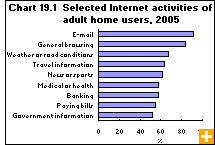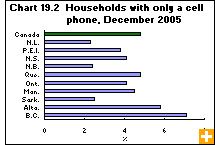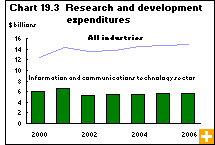Common menu bar links
Information and Communications Technology
Archived Content
Information identified as archived is provided for reference, research or recordkeeping purposes. It is not subject to the Government of Canada Web Standards and has not been altered or updated since it was archived. Please contact us to request a format other than those available.
Information and communications technologies (ICTs) play a major role in Canadians’ daily lives. Technologies such as wireless networks, software and the Internet have transformed the way we communicate and access information at home, work, school and on our daily commutes.
In 2005, almost 17 million adult Canadians, or 68% of the population age 18 and older, used the Internet for personal, non-business reasons. About 90% of them, 15 million, accessed it from home.
The vast majority of home users, 91%, went online to send and receive e-mail, and 84% used the Internet for general browsing. Gathering information and conducting personal business took precedence over entertainment, such as playing games or listening to the radio online. Roughly 6 out of 10 adult Internet users accessed weather or road reports, viewed news and sports, searched for medical or health-related information, obtained travel information and made bookings, and did personal banking.
About 50% of those using the Internet from home in 2005 did so via a cable connection; 44% used a telephone line. Over 80% of all home Internet users had a high-speed connection. Internet use is concentrated in urban areas, among adults under 45, people with postsecondary education, in households with children and in high-income households.
Businesses also use the Internet to their advantage. Private sector businesses’ online sales surged 42% in 2006 from the year before to $46.5 billion. Most of these transactions, $31.4 billion worth, were business-to-business sales. In 2006, 45% of Canadian firms made purchases online. The principal benefits of conducting business over the Internet were reaching new customers (36% of firms) and better coordination with suppliers, customers or partners (35%). Only 27% reported that conducting business over the Internet lowered costs.
Households spending more on technologies
Canadians spent more on Internet access, cell phone and other wireless services, computer hardware, and satellite and cable television subscriptions in 2005 than in 2004. In contrast, household spending on telephone land-line, or wireline, services continued to decline.
Annual spending on cell phone and other wireless services reached an average $410 per household in 2005, up more than 21% from 2004, whereas annual spending on wireline telephone service fell 3% to an average $680. Households spent 8% more on computer hardware in 2005, averaging $290 and almost matching the peak set in 2000.
Households also upped their spending on Internet access 15% in 2005, from 2004, to an average $240. The proportion of households having high-speed Internet access grew to 50% in 2005, up from 43% in 2004.
One in five households owned a satellite television receiver in 2005, about the same proportion as in 2004. However, in 2005 average annual household spending on satellite subscriptions rose 17% from the year before to $138. More than three in five households subscribed to cable television in 2005: spending on these services rose only 1% from 2004, to $348.
Wireless is winning
Wireless communications technology again gained market share in 2006, and was the telecommunications industry’s most profitable segment, with operating profit margins of almost 32%. The wireline providers’ profit margins were half that, 16%.
Wireless telephone subscriptions rose above the 18-million mark in 2006, whereas the number of residential telephone wirelines fell to just over 11 million. The loss of residential telephone customers lowered the operating profits for providers of traditional wireline systems by 14% in 2006 to $3.5 billion.
Not only has the wireless industry continued to attract more subscribers, but it has also persuaded subscribers to make greater use of their devices and to spend more on services. At the end of 2006, operating revenue per subscriber had risen 7.2% to $190 per subscriber, compared with $177 in 2005.
But the most striking change in the wireless market is the convergence in usage rates with traditional phone services. At the end of 2006, Canada had 55.1 mobile subscribers per 100 inhabitants and 55.3 traditional wireline access lines per 100 inhabitants. That compares with 18.7 wireless subscribers per 100 inhabitants and 64.4 traditional wireline access lines per 100 inhabitants at the end of the first quarter of 1999. Clearly, more and more Canadians are adopting the technology as their principal telephone.
Sector maintains strength
The ICT sector contributed $65.0 billion in 2006 to Canada’s gross domestic product (GDP), accounting for 6% of total GDP—the same proportion as the year before. ICT services account for the majority of this sector’s revenues, 82% in 2006. ICT manufacturing accounted for 31% of this sector’s GDP at its peak in 2000. However, their contribution was halved to 16% by 2002, a level ICT manufacturing still held in 2006.
Research and development (R&D) investment by the ICT sector in 2006 was over $5.7 billion, about the same as in 2005. Annual R&D expenditures reached a high of $6.6 billion in 2001, but dropped to $5.3 billion in 2002 as the high-tech downturn took hold. Investment in R&D by the ICT sector accounted for 39% of total private sector R&D expenditures in 2006.
ICT manufacturing industries are among the most innovative in the manufacturing sector. Eighty percent of ICT manufacturing plants introduced a new or significantly improved product or production process to the market from 2002 to 2004. The top two ICT manufacturing industries were computer and peripheral equipment manufacturing, and radio and television broadcasting and wireless communications equipment manufacturing, in which 89% of plants were innovative.





